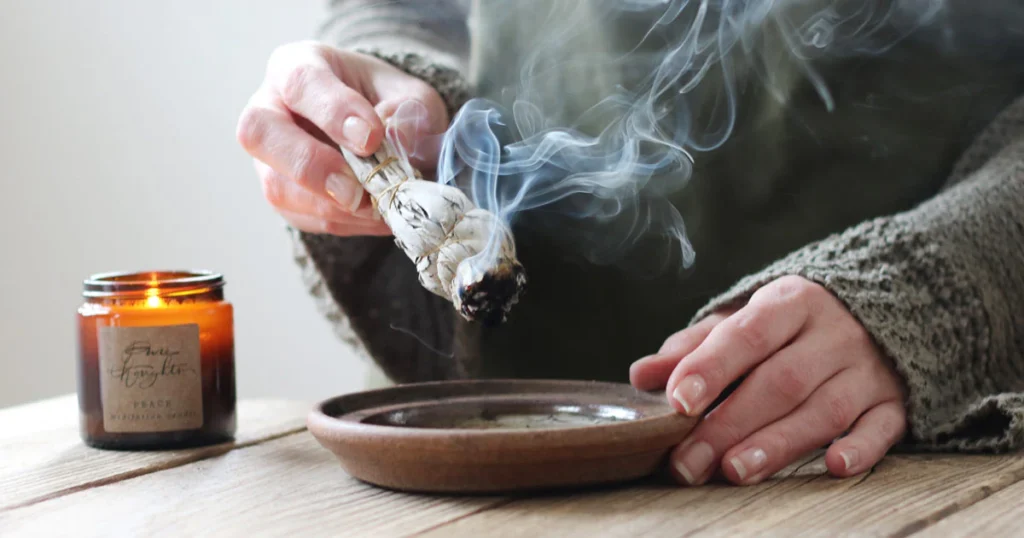In many cultures around the world, people believe that energy surrounds us. Just like we clean our homes physically, it’s also important to clean them energetically. One simple and powerful way to do this is through smudging.
Smudging is the practice of burning natural herbs or plants to clear negative energy, purify a space, and uplift your mood. Though it comes mainly from Native American traditions, similar rituals are seen in India and other parts of Asia.
In this article, you will learn what smudging is, why it’s done, which herbs to use, and how to do it safely at home, especially with ingredients available in Indian households.
What Is Smudging?

Smudging is a spiritual cleansing ritual. It involves burning sacred herbs or resins and letting the smoke move through your space, body, or objects. The smoke is believed to carry away unwanted energy and bring in peace and positivity.
People use smudging to:
- Cleanse a new home
- Remove negative energy after a fight or illness
- Clear their own aura before meditation or prayer
- Bless sacred spaces like a pooja room or altar
- Purify crystals, malas, or other spiritual tools
Also Read How to Create a Sacred Space at Home
The Science and Belief Behind It
From a spiritual view, smudging removes heavy or negative vibrations. From a scientific view, studies suggest that burning herbs like sage releases negative ions. These ions may help purify the air and improve mood.
In India, we see similar practices like:
- Burning dhoop (resin incense) in temples
- Using sambrani in homes after childbirth or festivals
- Waving camphor in aarti rituals to clear bad energy
All these are forms of energetic cleansing — just like smudging.
Common Herbs Used in Smudging
Different cultures use different plants for smudging. Here are some popular herbs, along with Indian alternatives:
1. White Sage
- Most commonly used in Western smudging.
- Strong cleansing herb.
Indian alternative: Dhoop sticks or Tulsi leaves.
2. Palo Santo
- A sacred wood from South America.
- Smells sweet and calming. Used to invite positive energy.
Indian alternative: Sandalwood chips or paste.
3. Lavender
- Soothes the mind and calms emotions.
- Can be burned alone or mixed with other herbs.
Indian alternative: Lavender essential oil on cotton or dried rose petals.
4. Frankincense and Myrrh
- Resin used in churches and temples.
- Known to purify and raise spiritual energy.
Indian equivalent: Guggul or loban resin, burned on charcoal.
5. Bay Leaf (Tej Patta)
- Easily found in Indian kitchens.
- Burning bay leaf is believed to reduce stress and ward off negativity.
How to Do Smudging at Home
You don’t need special tools to start smudging. Just follow these easy steps:
Step 1: Gather Your Tools
- A bundle of herbs or loose dried leaves
- A fire-safe bowl or clay pot (use brass or copper if possible)
- A matchstick or diya to light the herbs
- A feather or hand to wave the smoke (optional)
Step 2: Set Your Intention
Before you start, decide why you’re smudging. This could be:
- “I release stress from this space.”
- “I invite peace and protection into my home.”
- “I clear my aura of heavy thoughts.”
Hold this thought in your mind while smudging.
Step 3: Light the Herb or Resin
Light the tip of your smudge stick or loose herbs. Let it burn for a few seconds, then blow out the flame. It should produce smoke but not fire.
Step 4: Walk Around the Space
Move slowly through each room. Let the smoke reach corners, doorways, windows, and dark areas. You can chant a mantra like “Om Namah Shivaya” or simply repeat your intention.
If smudging yourself, guide the smoke from your feet to your head with your hand or a feather.
Step 5: Extinguish Properly
Once done, press the burning end into a fireproof bowl, sand, or soil to put it out completely. Never leave smudge herbs burning unattended.
When to Smudge
Smudging is best done during:
- New moon or full moon days
- After illness or emotional stress
- Before meditation, prayer, or pooja
- After moving into a new home
- After guests leave (to reset the space)
Safety Tips
- Always use a fireproof container.
- Open windows for ventilation.
- Keep water nearby in case of emergency.
- Pregnant women and people with breathing problems should avoid strong smoke.
- Be mindful of allergies to herbs like sage or incense.
Respecting the Practice
Though smudging is effective, it’s important to respect its roots. Native American communities view smudging as a sacred ritual. Always perform smudging with intention and awareness, not just as a trend.
Indian Spiritual Alternatives to Smudging
If you do not wish to use foreign herbs, here are Indian practices with the same purpose:
- Burning camphor during aarti
- Dhoop or sambrani after bathing or cleaning the house
- Using Tulsi, neem, or mango leaves in rituals
- Chanting Vedic mantras or lighting a ghee diya to purify space
These are traditional Indian ways of clearing energy and blessing the home.
FAQs on Smudging
Q: Can I smudge every day?
Yes, but most people do it weekly or during special occasions. Listen to your intuition.
Q: Is it okay to smudge if I live in a rented flat?
Yes. Just ensure good ventilation so smoke doesn’t disturb others.
Q: Can I smudge without herbs?
Yes. You can use essential oils, incense sticks, or even sound (bells or chanting) to shift energy.
Q: Do I need to believe in it for it to work?
Belief helps, but the act of slowing down and setting intention already makes a difference.
Q: Is smudging against Indian traditions?
Not at all. In fact, India has many similar practices. Smudging is just another way to cleanse and connect.
Final Thoughts
Smudging is a simple but meaningful way to clean your space, uplift your spirit, and support your daily well-being. Whether you use sage, bay leaf, dhoop, or sandalwood, the goal is the same — to invite clarity, calm, and good energy.
You don’t need big rituals or rare ingredients. A few minutes, a little smoke, and a clear intention can transform your home into a place of light and peace.
So take a deep breath, light your herbs, and let the healing begin.










